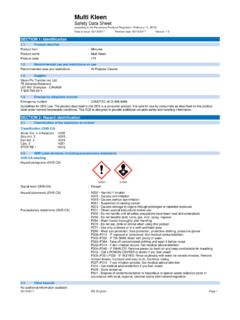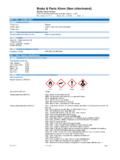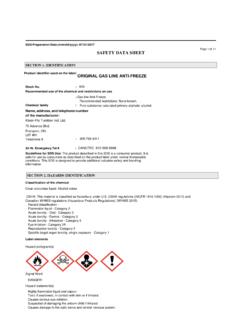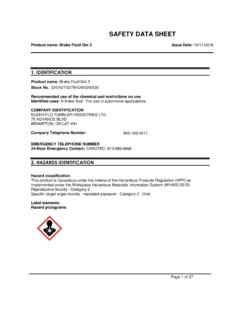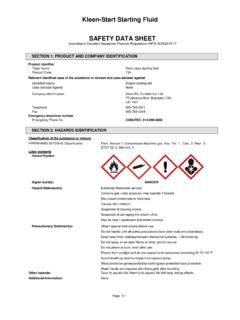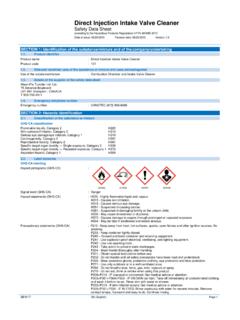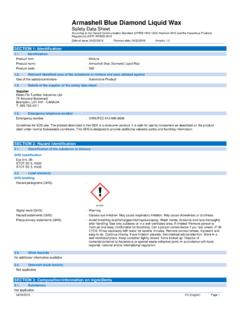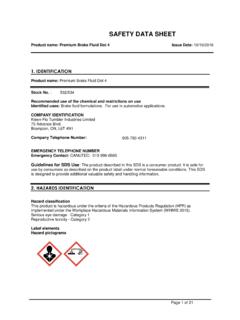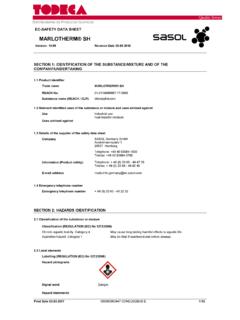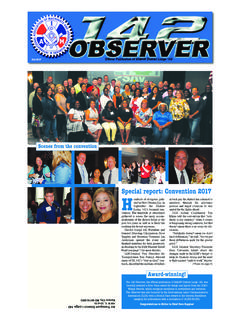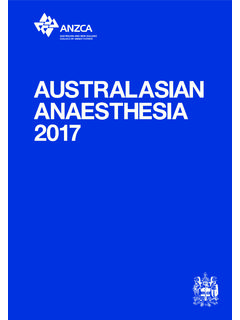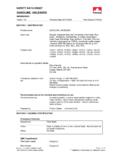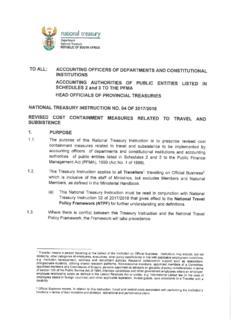Transcription of Air Tool Oil - Kleen-Flo
1 Air Tool Oil Safety Data Sheet according to the Hazardous Products Regulation (February 11, 2015). Date of issue: 02/28/ 2017 Revision date: 02/28/ 2017 Version: SECTION 1: Identification Product identifier Product form : Mixtures Product name : Air Tool Oil Product code : 4168/4169. Recommended use and restrictions on use Recommended use : Pneumatic tool lubricant Supplier Manufacturer Kleen-Flo Tumbler Industries Ltd. 75 Advance Blvd. L6T 4N1 Brampton - Canada T (905) 793-4311. Emergency telephone number Emergency number : CANUTEC 613-996-6666. Guidelines for SDS Use: The product described in this SDS is a consumer product. It is safe for use by consumers as described on the product label under normal foreseeable conditions.
2 This SDS is designed to provide additional valuable safety and handling information. SECTION 2: Hazard identification Classification of the substance or mixture Classification (GHS-CA). Flam. Liq. 4 H227. Repr. 1A H360. Asp. Tox. 1 H304. GHS Label elements, including precautionary statements GHS-CA labelling Hazard pictograms (GHS-CA) : GHS08. Signal word (GHS-CA) : Danger Hazard statements (GHS-CA) : H227 - Combustible liquid H304 - May be fatal if swallowed and enters airways H360 - May damage fertility or the unborn child Precautionary statements (GHS-CA) : P201 - Obtain special instructions before use P202 - Do not handle until all safety precautions have been read and understood.
3 P210 - Keep away from heat, hot surfaces, sparks, open flames and other ignition sources. No smoking P280 - Wear protective gloves/protective clothing/eye protection/face protection P308+P313 - IF exposed or concerned: Get medical advice/attention P301+P310 - IF SWALLOWED: Immediately call a POISON CENTER or doctor P331 - Do NOT induce vomiting P403 - Store in a well-ventilated place P405 - Store locked up P501 - Dispose of contents/container to hazardous or special waste collection point, in accordance with local, regional, national and/or international regulation Other hazards No additional information available Unknown acute toxicity (GHS-CA). Not applicable SECTION 3: Composition/information on ingredients Substances Not applicable Mixtures Name Product identifier %.
4 Distillates, petroleum, hydrotreated light naphthenic (CAS No) 64742-53-6 7-13. Stoddard solvent (CAS No) 8052-41-3 7-13. Methyl salicylate (CAS No) 119-36-8 02/28/ 2017 EN (English) Page 1. Air Tool Oil Safety Data Sheet according to the Hazardous Products Regulation (February 11, 2015). SECTION 4: First-aid measures Description of first aid measures First-aid measures after inhalation : If breathing is difficult, remove victim to fresh air and keep at rest in a position comfortable for breathing. Get medical advice/attention if you feel unwell. First-aid measures after skin contact : If skin irritation occurs: Wash skin with plenty of water. Obtain medical attention if irritation persists.
5 First-aid measures after eye contact : IF IN EYES: Rinse cautiously with water for several minutes. Remove contact lenses, if present and easy to do. Continue rinsing. If eye irritation persists: Get medical advice/attention. First-aid measures after ingestion : IF SWALLOWED: rinse mouth. Do NOT induce vomiting. Never give anything by mouth to an unconscious person. Immediately call a POISON CENTER or doctor/physician. Most important symptoms and effects (acute and delayed). Symptoms/effects after inhalation : May cause irritation to the respiratory tract. Symptoms/effects after skin contact : May cause skin irritation. Symptoms may include redness, drying, defatting and cracking of the skin.
6 Symptoms/effects after eye contact : May cause eye irritation. Symptoms may include discomfort or pain, excess blinking and tear production, with possible redness and swelling. Symptoms/effects after ingestion : May be fatal if swallowed and enters airways. May cause gastrointestinal irritation, nausea, vomiting and diarrhea. May result in aspiration into the lungs, causing chemical pneumonia. Immediate medical attention and special treatment, if necessary Other medical advice or treatment : Symptoms may be delayed. In case of accident or if you feel unwell, seek medical advice immediately (show the label where possible). SECTION 5: Fire-fighting measures Suitable extinguishing media Suitable extinguishing media : Carbon dioxide (CO2), dry chemical powder, foam.
7 Water spray or fog. Unsuitable extinguishing media Unsuitable extinguishing media : Do not use water jet. Specific hazards arising from the hazardous product Fire hazard : Combustible liquid. Products of combustion may include, and are not limited to: oxides of carbon. Special protective equipment and precautions for fire-fighters Firefighting instructions : Cool closed containers exposed to fire with water spray. Protection during firefighting : Keep upwind of fire. Wear full fire fighting turn-out gear (full Bunker gear) and respiratory protection (SCBA). SECTION 6: Accidental release measures Personal precautions, protective equipment and emergency procedures General measures : Use personal protection recommended in Section 8.
8 Isolate the hazard area and deny entry to unnecessary and unprotected personnel. Use special care to avoid static electric charges. Remove all sources of ignition. Methods and materials for containment and cleaning up For containment : Absorb and/or contain spill with inert material (sand, vermiculite or other appropriate material), then place in suitable container. Do not flush into surface water or sewer system. Wear recommended personal protective equipment. Methods for cleaning up : Sweep or shovel spills into appropriate container for disposal. Provide ventilation. Reference to other sections For further information refer to section 8: "Exposure controls/personal protection".
9 SECTION 7: Handling and storage Precautions for safe handling Precautions for safe handling : Avoid breathing dust, fume, gas, mist, spray, vapours. Avoid contact with skin, eyes and clothing. Do not swallow. Handle and open container with care. When using do not eat, drink or smoke. Keep away from sources of ignition - No smoking. Take precautionary measures against static discharge. Use only non-sparking tools. Hygiene measures : Wash contaminated clothing before reuse. Always wash hands after handling the product. Conditions for safe storage, including any incompatibilities Storage conditions : Keep out of the reach of children. Keep container tightly closed.
10 Store away from direct sunlight or other heat sources. Store in a dry, cool and well-ventilated place. Store locked up. SECTION 8: Exposure controls/personal protection Control parameters Stoddard solvent (8052-41-3). USA - ACGIH ACGIH TWA (ppm) 100 ppm Appropriate engineering controls Appropriate engineering controls : Ensure good ventilation of the work station. Environmental exposure controls : Avoid release to the environment. 02/28/ 2017 EN (English) 2/5. Air Tool Oil Safety Data Sheet according to the Hazardous Products Regulation (February 11, 2015). Individual protection measures/Personal protective equipment Hand protection: Wear suitable gloves resistant to chemical penetration Eye protection: Wear eye/face protection Skin and body protection: Wear suitable protective clothing Respiratory protection: In case of insufficient ventilation, wear suitable respiratory equipment.
